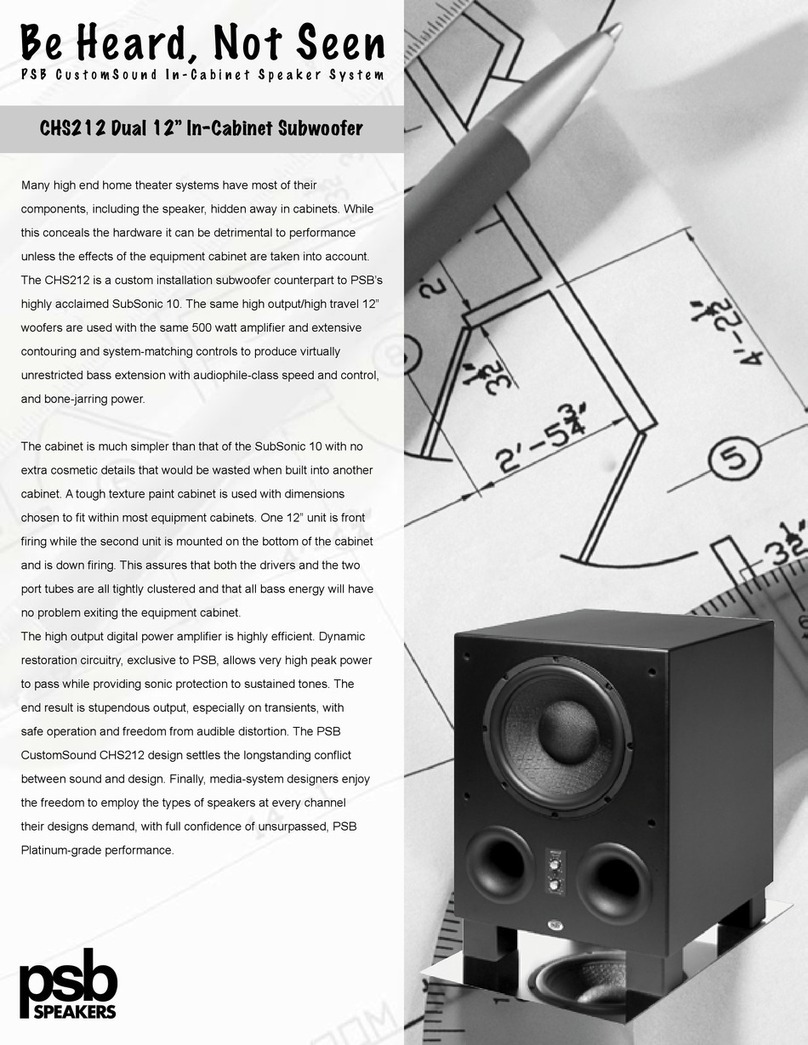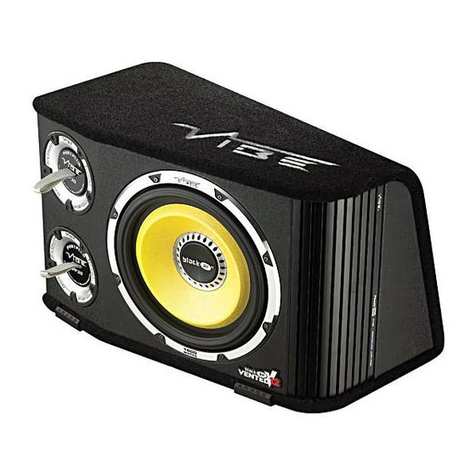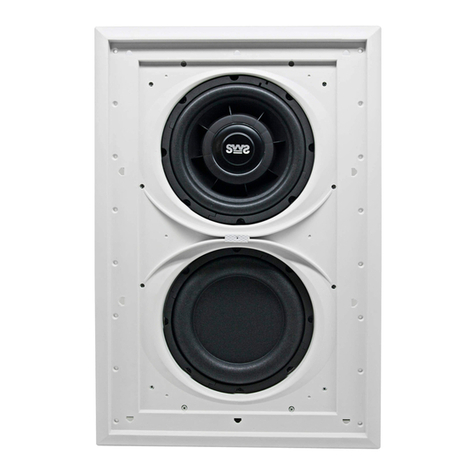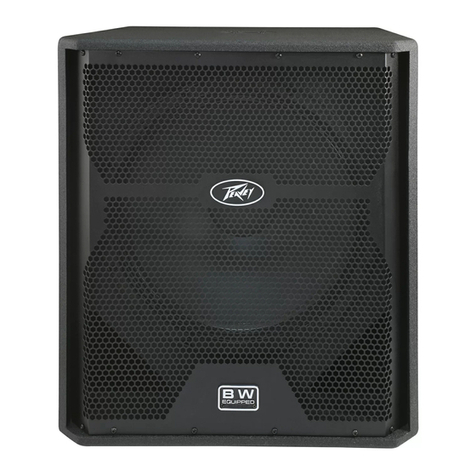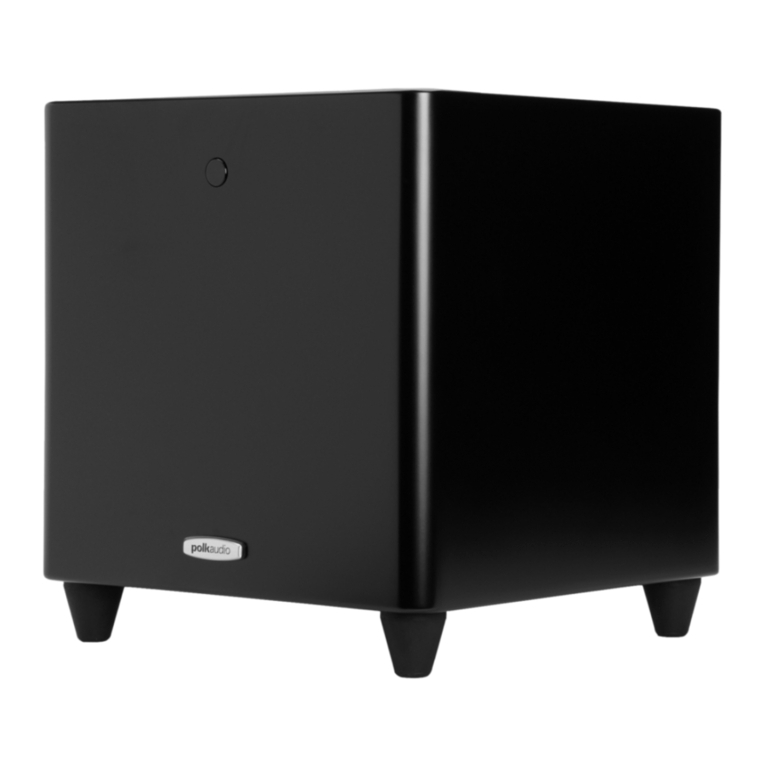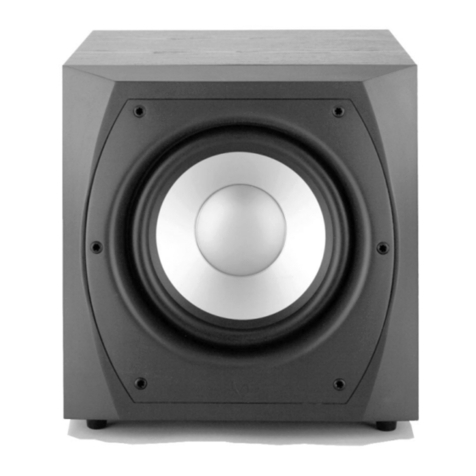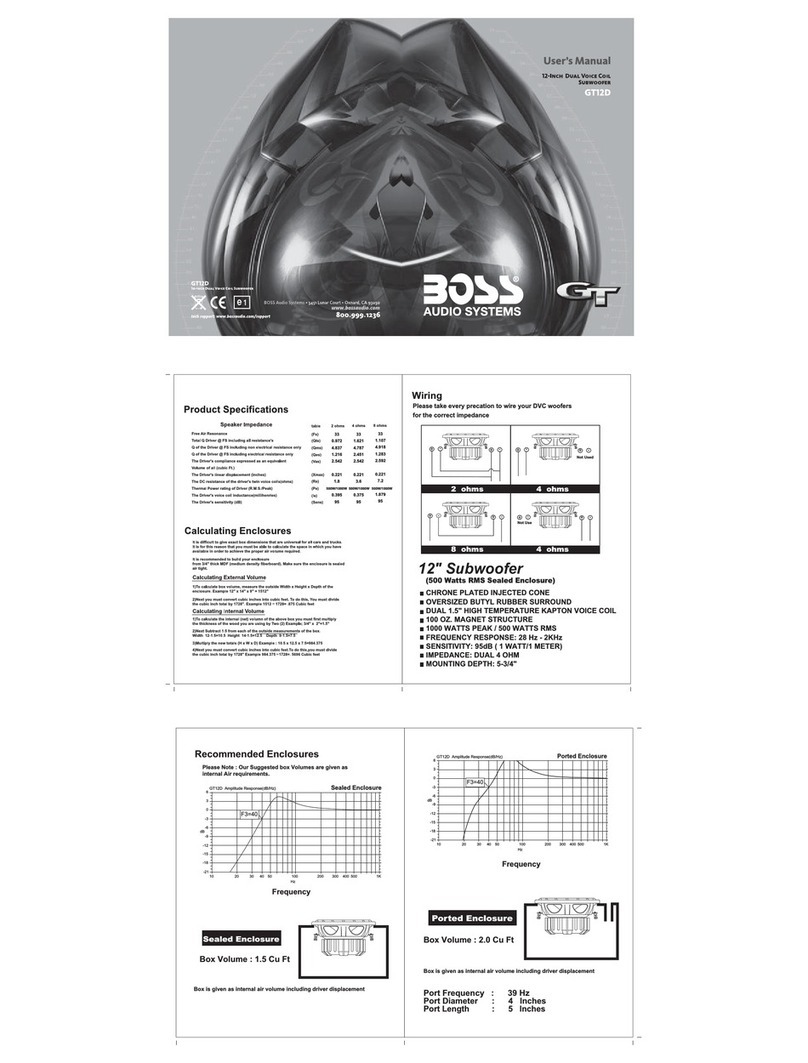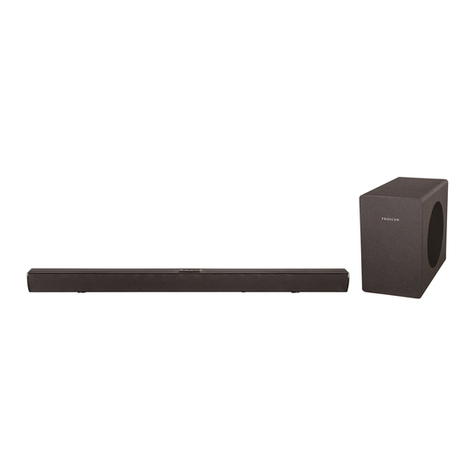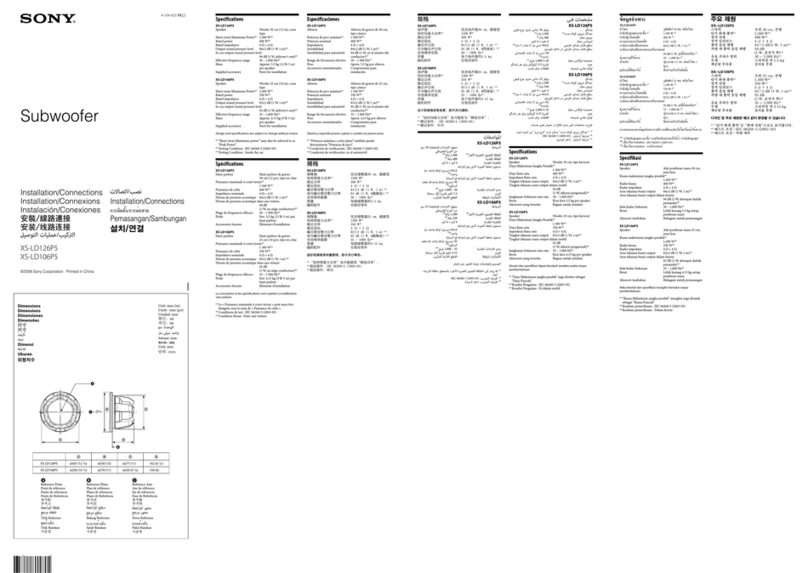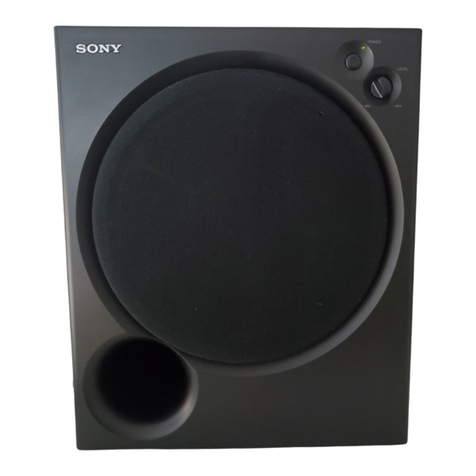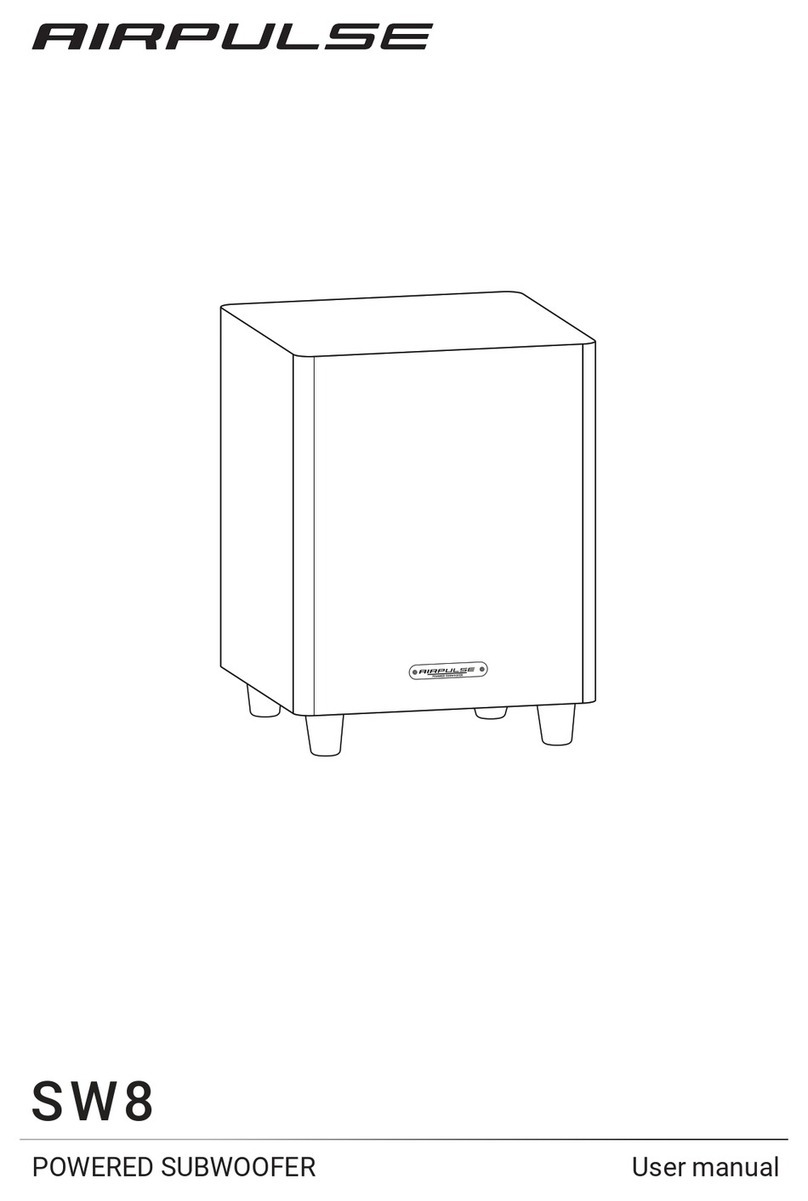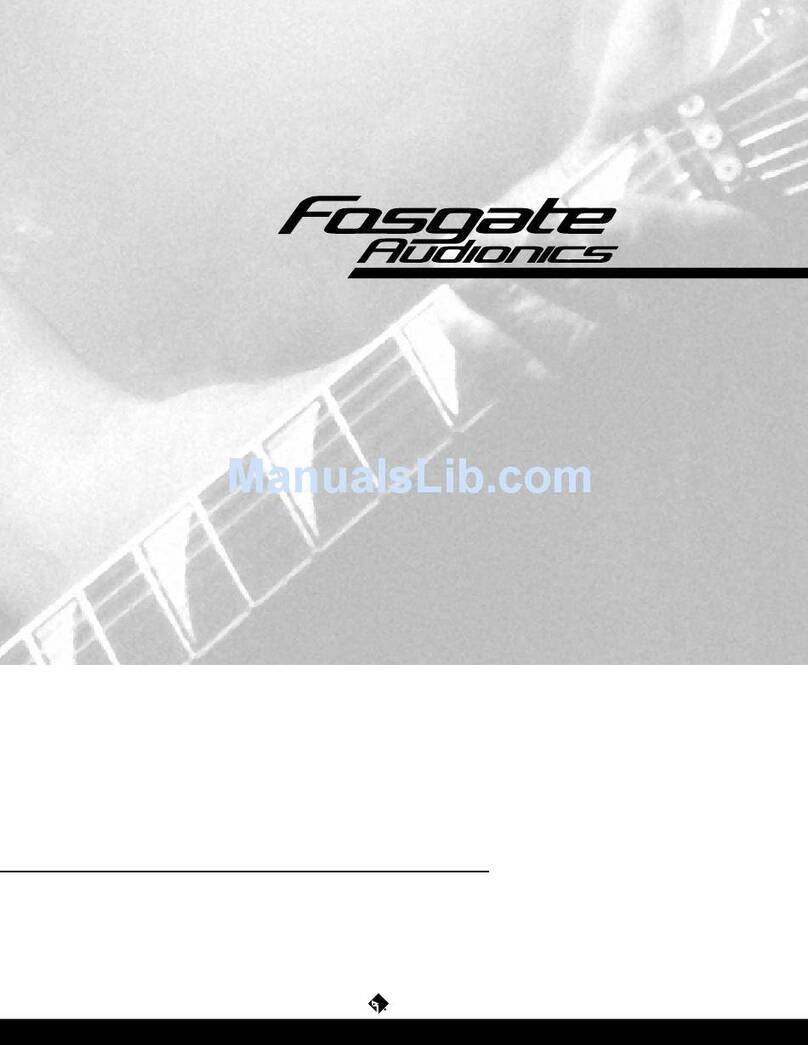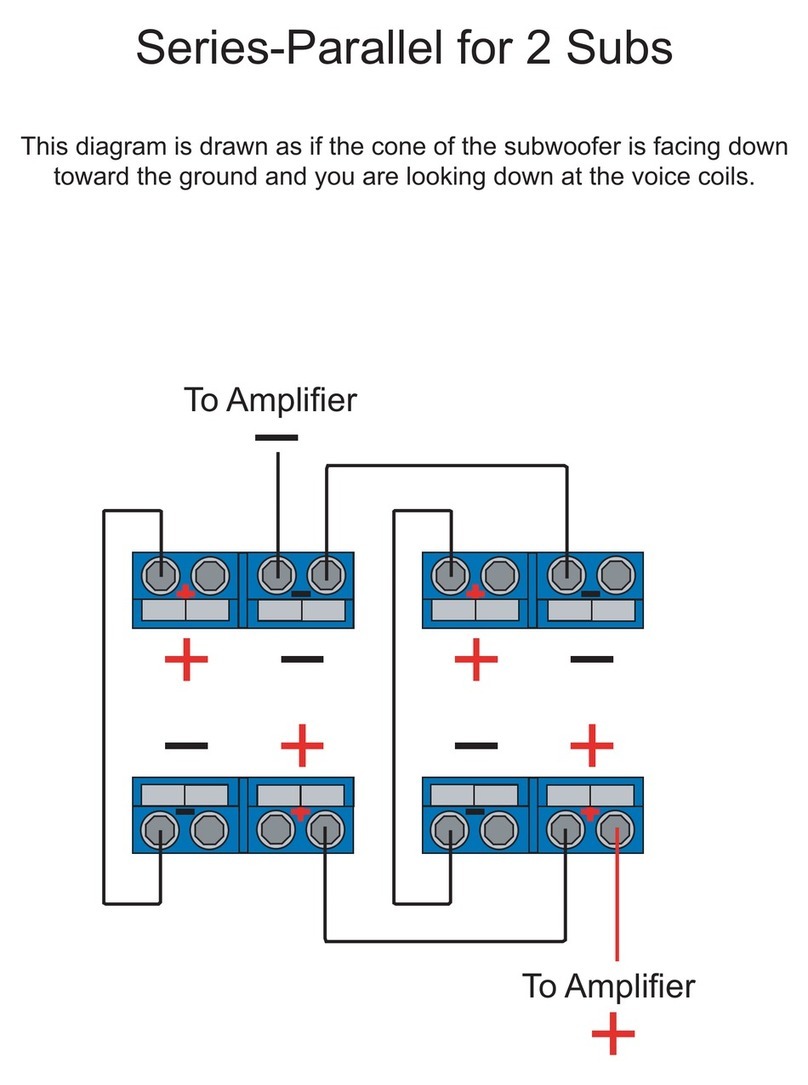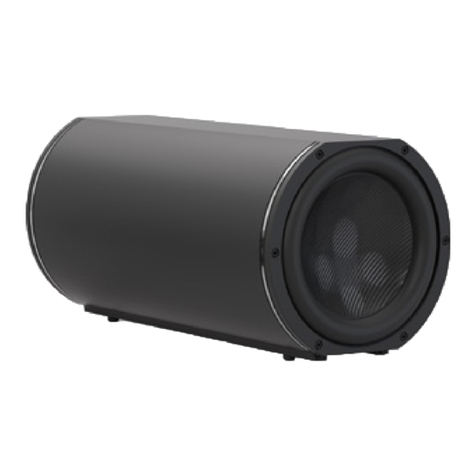PSB HD8 User manual

Owner’s Manual
HD8
HD10
HD8
HD10
Powered Subwoofers

2
CONTENTS
I.
II.
III.
IV.
V.
VI.
VIII.
High/Speaker Level Terminals
Amplifier Panel
On/Standby Indicator Lights
AC Power Socket
IX.
A.
B.
C.
D.
X.
XI.
XII.
Important Safety Instructions
Introduction
Warranty Registration
Cabinet Care
Room Acoustics, Subwoofer Placement, Multiple Subwoofers and
Setting the Controls
About Bass Management
Features, Controls, AC Power (Figure 1)
Bass Level
Trigger Input Jack
Crossover Control
Phase Control
Stereo Low/Line Level Jack
LFE Input/Output Jacks
AC Power Connection
Power Switch
External Fuse
Connecting The Subwoofer To Your Audio System
Connecting Home Theater Equipment
Connecting Stereo Equipment Using Low/Line Level
Connecting Stereo Equipment With High/Speaker Level
Using Multiple Subwoofers
Set-up Calibration
In Case Of Problems
Specifications
Quick StartVII.

I. Important Safety Instructions
1. Read these instructions.
2. Keep these instructions.
3. Heed all warnings.
4. Follow all instructions.
5. Do not use this apparatus near water.
6. Clean only with dry cloth.
7. Do not block any ventilation openings. Install in accordance with the manufacturer's
instructions.
8. Do not install near any heat sources such as radiators, heat registers, stoves, or other
apparatus (including amplifiers) that produce heat.
9. Do not defeat the safety purpose of the polarized or grounding-type plug. A polarized plug
has two blades with one wider than the other. Agrounding type plug has two blades and a
third grounding prong. The wide blade or the third prong is provided for your safety. If the
provided plug does not fit into your outlet, consult an electrician for replacement of the
obsolete outlet.
10. Protect the power cord from being walked on or pinched particularly at plugs, convenience
receptacles, and the point where they exit from the apparatus.
11. Only use attachments/accessories specified by the manufacturer.
12. Unplug this apparatus during lightning storms or when unused for long periods of time.
13. Refer all servicing to qualified service personnel. Servicing is required when the apparatus
has been damaged in any way, such as power-supply cord or plug is damaged, liquid has
been spilled or objects have fallen into the apparatus, the apparatus has been exposed to
rain or moisture, does not operate normally, or has been dropped.
14. WARNING: To reduce the risk of fire or electric shock, this apparatus should not be exposed
to rain or moisture and objects filled with liquids, such as vases, should not be placed on this
apparatus.
15. To completely disconnect this equipment from the mains, disconnect the power supply cord
plug from the receptacle.
16. The mains plug of the power supply cord shall remain readily operable.
The lightning flash with arrowhead symbol within an equilateral triangle is intended to
alert the user to the presence of uninsulated "dangerous voltage” within the product's
enclosure that may be of sufficient magnitude to constitute a risk of electric shock to
persons.
The exclamation point within an equilateral triangle is intended to alert the user to the
presence of important operating and maintenance (servicing) instructions in the
literature accompanying the product.
Notes on environmental protection
At the end of its useful life, this product must not be disposed of with regular household
waste but must be returned to a collection point for the recycling of electrical and
electronic equipment. The symbol on the product, user's manual and packaging, point
this out.
The materials can be reused in accordance with their markings. Through re-use,
recycling of raw materials, or other forms of recycling of old products, you are making an
important contribution to the protection of our environment.
Your local administrative office can advise you of the responsible waste disposal point.
3

II. Introduction
PSB subwoofers are designed to provide the flattest possible frequency response,
full bass extension, low distortion and high output. Frankly, these are characteristics
that most manufacturers would strive for. Our years of experience and our
sophisticated design and measurement tools allow us to achieve ideal subwoofer
performance. Beyond these characteristics there are a few other parameters that
we uniquely feel are very important in the design of a subwoofer. First and foremost it
is important to us that a PSB subwoofer be musical. In this era of home theater this
might at first seem out of step, but we believe that a musical subwoofer will also
sound the most natural when playing movie soundtracks.
Achieving high performance in a compact subwoofer poses serious design
challenges. In theory increasing the woofer’s moving mass, to counteract the
stiffness of the air within a small enclosure volume, along with upping the amplifier
power to counteract the attendant loss of sensitivity are all that are required to
achieve high performance in a compact subwoofer. In reality shrinking the system
makes every aspect of design much more difficult. Aported box design which gives
lowest distortion is virtually impossible as the vents need to be large in area and
considerably longer. They would quickly consume the precious volume of the box.
Passive radiators will achieve what ports achieve in a larger box, but high mass is
required and high excursion must be allowed for. The woofer also needs both
incredibly high mass and equally high motor strength to offset the acoustic
“stiffness” of the air within a compact enclosure volume. An amplifier with the highest
wattage of any PSB subwoofer amplifier ever assures that amplifier drive is not a
limiting factor. Since all of these components have to be more robust than with
conventional designs their cost and mass increase. In the end the PSB HD subs are
constructed with rugged and heavy components masterfully squeezed into a small
enclosure volume. For this reason we’ve chosen to name the new models our HD
Subs for “High Density”. In the end the musicality our subwoofers are known for is
also preserved, so HD could also stand for “High Definition”.
An ideal subwoofer should have the ability to maintain accuracy even under
conditions of overload or stress. No subwoofer is so large with its limits so great that
it can never be overloaded, especially with modern movie soundtracks. For this
reason PSB subwoofers incorporate very intelligently applied proprietary limiting
circuitry to prevent audible overload.
The limiting circuitry of all PSB subwoofers is a combination of peak limiting circuits
that hold amplifier signal swing to the point just short of the amplifiers clipping, and
compression circuitry that will come in under conditions of long term overload and
reduce the amplifiers gain. The trick is to apply these circuits in such a way that they
don't squeeze the life out of the music or movie soundtrack, they must allow the
dynamics to get through while preventing gross distortion. We do this by being
mindful of the dynamics of music and carefully tailoring the time constants of the
circuits to that of music. For example, it is known that most music is performed with a
beat of 80 to 140 beats per minute. Our test signals are configured to follow this
timing and allow maximum transient effect without distorting on sustained tones.
We go to great lengths to reduce any mechanical noises our subwoofers may make.
For example our woofers are designed never to bottom harshly. Woofers and
passive radiators are designed to maintain high excursion without rubbing ticking or
creating air noises. Cabinets and amplifiers are designed so that no air leaks (which
4

can contribute minute amounts of noise) are possible. All of our designs are
exhaustively tested. A subwoofers design isn't complete until all components can
survive a 15 hour test of being driven continuously to maximum output.
Amplification
As in all other current SubSeries subwoofers, these subwoofers utilize a high
efficiency high power class H power amp. Briefly, audio amplifiers are inherently
inefficient because they are designed to have the capability of delivering great
output power yet spend most of their life delivering fairly low power. Their output
devices must deliver current while withstanding the high power supply “rail” voltages
needed for peak outputs. With a Class H design the rail voltages are not constant.
They swing high when the music demands it and stay low during quiet passages.
This is achieved by a sophisticated music modulated high frequency switching
power supply. Power dissipated as heat is greatly reduced and more power is
available per dollar of cost. A second benefit is that they tend to have high peak
power relative to their steady state power. The HD10, for example, has 750 watts
continuous but is capable of over 1000 watt peaks. The result is a subwoofer
capable of the great transients required by dynamic music and explosive sound
effects. The HD8 and 10 offer the latest most efficient implementation of this special
Class H technology.
The HD subwoofer’s heavy passive radiators are mounted in a dual opposing
design to drastically reduce cabinet vibrations. For lowest bass notes, an opposed
force would be exerted by a single passive radiator. This force attempts to move the
cabinet opposite the radiators movement. By mounting the dual passive radiators
on opposing cabinet faces, the reaction forces nullify each other and no energy is
lost due to these forces acting on the cabinet. Residual force from woofer movement
may still impart some vibration to the cabinet. In our early testing we noted that, at
maximum levels, the cabinet would tend to “walk” along the floor. We solved the
problem by designing special compliant feet with enough “give” to absorb cabinet
vibration and keep the HD Subwoofer in one place.
Severe duty aluminum cast baskets, very large magnet structures, and high power
voice coils allow the HD8 and HD10 to effortlessly churn out low frequencies at
foundation shaking levels and to do so for years to come.
Whichever PSB subwoofer you have chosen, we hope that you appreciate the
attention to detail that has gone into its design and, of course, that you enjoy using it.
Please take the time to read the following sections about the placement of your
subwoofer, and its connections and adjustments.
III. Warranty Registration
We recommend you take a few moments now to register your warranty, preferably
on-line at www.psbspeakers.com or via the enclosed registration form so that we will
be able to serve you better in the future.
Unpacking
The packing materials of your PSB HD Subwoofers are designed to protect them
from damage during shipping. Retain the packaging in case the need arises to
transport the speakers in the future.
5

IV. Cabinet Care
Cabinets have varying materials and finishes, including painted wood, perforated
metal and rubber passive radiator and trim parts. They should be treated as you
would any fine component with similar finishes. Dust lightly with a soft cloth; avoiding
abrasives. If necessary, wipe carefully with a cloth slightly dampened with glass
cleaner to remove heavy soil.
V. Room Acoustics, Speaker Placement, Multiple Subwoofers
and Setting Controls
Room Acoustics
If you are critical about low-frequency response, there's quite a bit of useful
experimentation you can do, especially in combination with the crossover, level, and
phase controls of our subwoofers.
Since the earliest days of high fidelity, one of the main challenges for the designers
of speakers, and of their users, has been the generation of the lowest
frequencies—the deep bass. Many of the most notable developments in speaker
design have been made with a view to getting more bass output from smaller boxes.
One consideration is the size of the listening room. The larger the volume of air a
speaker must excite, the more acoustic output you will require from it to achieve the
sound levels you want. In any environment, sounds attenuate as you move farther
away from their source, but in smaller rooms that tends to be offset by reinforcement
from wall reflections. The larger the space is, the farther the sound has to travel both
to reach the reflecting surfaces and then to get to your ears, which means it has to be
louder to begin with.
With traditional full-range speakers, that involves an intricate matching act between
amplifier power, speaker sensitivity, impedance and power handling. But the bulk of
the power goes to reproducing bass, so the use of powered subwoofers and
separate midrange/treble satellites both allows you to be conservative in the amount
of power your main amplifier produces, and ensures a good match between the low-
frequency amplifier and the woofer it is paired with.
After size, the most important aspect of a listening room is its shape. In any room,
sound reflects off the walls, ceiling, and floor. If the distance between two opposite
parallel surfaces is a simple multiple of the wavelength of a particular frequency,
notes of that frequency will bounce back and forth in perfect phase—an effect called
a standing wave or room mode.
At some points in the room, this note will be reinforced substantially; at others it will
cancel out almost entirely. If the prime listening seat is placed at either of these
locations, the note will be a horrible boom or virtually non-existent. The standing
waves are different between floor and ceiling, side walls, and end walls, unless any
of these dimensions are the same. An ideal listening room would have no parallel
surfaces—an unusual situation, to say the least—so that such waves would not
establish themselves. The worst kind of room is a perfect cube.
Almost all rooms are susceptible to some standing waves at low frequencies, but
their effects can be minimized by careful positioning of both the speakers and the
listening seat. Moving either of these even a few inches is sometimes enough to
cure—or create—an intolerable sound. The only way to find out what works best is
by experimentation.
6

With full-range speakers, the range of places you can put the speakers and still get
proper imaging may be fairly limited, and some of these positions may result in
standing waves that can't be tamed. Things are more controllable through the use of
a subwoofer or two. Positioning of the bass speakers has almost no impact on
imaging, so a subwoofer can be located with only standing waves in mind
Subwoofer Placement
There is no argument among audiophiles that the loudest bass output from a
subwoofer comes from corner placement. The natural megaphone-like flaring
outward of walls from a room corner focuses low frequencies—giving them no place
to go but toward you. In the case of subwoofers, there is no automatic penalty in
giving overall balance for this maximal bass, since your main speakers can be
located elsewhere. It still may be too much bass for your room or (more particularly)
your favorite listening spot in the room, but unless you are seated in a “null” spot,
where sound from the sub is cancelled or diminished by out-of-phase reflections
from elsewhere, there should be plenty of bass from corner placement.
If you are seated in such a null spot, your only real choices are generally to move
either the subwoofer or your listening position until bass returns to the point that
satisfies. Cranking up the level control or changing the crossover point almost
certainly won't help much. But rotating the variable phase control 180 degrees
sometimes may make a difference, especially if the null is a product of cancellations
caused by interaction with low frequencies from your main speakers.
If you are in the opposite sort of situation, where direct and reflected bass waves
converge in phase and produce a strong peak at your listening location, you can—if
you like—deal with that both with changes in placement or in the position of your
sub's level control (or, less likely but possible, the crossover frequency chosen). We
say “if you like” because there is no such thing as too much bass for some listeners,
and we don't want to be dogmatic. You are definitely the one who has to be pleased,
unless your Significant Other chimes in to the contrary.
As you go outward from the corner along one wall or another, the general consensus
(with which we tend to agree) is that while bass output diminishes somewhat, it also
becomes more uniform throughout the room, with fewer of the “standing waves” that
produce peaks and nulls at various points.
Chances are things won't be so simple, so the best method for positioning a
subwoofer, although a rather undignified-looking one, is to put the subwoofer in your
listening chair, then play music with lots of bass through the system something with
steady low frequencies (such as organ music) or continuous test tones, not movie
material. Move around the room and note where the bass sounds best; if you place
the subwoofer there and yourself in your chair, you should get the same bass
performance. Bear in mind that the test only works if you have your ears as high off
the floor as the subwoofer will be, so don't be afraid to crawl around. Arecommended
starting point for the placement of this subwoofer would be in either of the front
corners of the room (on either side of the main speakers).
Rather than mounting your HD Sub in the open you might choose to mount it within a
cabinet or “wall unit” intended for hiding away the components of your home theater.
When cabinet mounted a few extra details must be attended too. The woofers on the
HD Subs are placed on the front face and the passive radiators on the sides where
they can all be placed reasonably close to a “sonic exit” of the cabinet. The cabinet
may have a front door with a grille (cloth or latticework). It may also have a solid front
7

as long as a substantial slot (typically 4” by 17” or more) is near the woofers. The best
location for this slot would be at floor level in line with the area to the front of the
cabinet. An inch or so of space between the front firing woofer and the cabinet front
will create enough of a channel for the bass to get down to a floor level slot.
If an HD Sub is within a cabinet, special attention should be given to preventing
rattles from strong bass tones. Rattles can be found by repeatedly playing a
selection with a variety of strong sustained bass tones. Action movies with a lot of
LFE (low frequency effects) content can be helpful as well. With the other speakers
down, turn the level up to the highest level likely to be encountered and listen closely
for rattles. If they occur, find the cabinet panels that are causing the rattle. Usually a
joint or contact area between two surfaces is vibrating and this is the cause of the
rattle. Some foam tape or the commonly available self adhesive felt discs, placed
between the offending surfaces will damp the rattle. Absorptive material, such as
fiberglass, may help damp internal resonances of the cabinet's cavities, but it will
need to be quite thick to have significant effect. Filling the full cavity above the
subwoofer can give a significant improvement, just be sure that the woofers and
their bass exit path are not obstructed. Although it normally runs cool, be especially
sure that any heat generated by the rear amplifier has an exit path and that no
materials are in contact with its metal surfaces.
Multiple Subwoofers—Why Two SubsAre Better Than One
Since the objective of most people who buy subs is to make sure of plentiful low
frequencies, the only situation most of us will run into that makes subwoofer
placement really difficult is the factor we all fear—the “bad” room that just won't let
you get satisfying amounts or quality of bass. There are rooms with troublesome
dimensions, especially as you approach a perfect cube (with closed doors and no
other natural openings). There is unlikely to be any combination of speaker and
listener position that will be free of obvious acoustic anomalies.
In such a case, the best way to iron out those anomalies is with two subwoofers,
placed carefully to work with each other. This can also be true when the problem is
too much, or too uneven, bass. Recent studies have proven that 2 subwoofers
carefully placed will give more even response over a listing area. These studies
show that mounting one woofer in the center (at floor level) of the front wall,
balanced by the second woofer in the center of the back wall will usually give a best
solution. Alternatively, having one woofer at the center of the left wall balanced by a
second woofer centered on the right wall will give similarly good results.
Setting the Subwoofer Controls
Once a reasonably smooth response has been achieved by careful positioning of
the subwoofers, the overall performance can be further improved by means of the
controls found on the speaker.An important one is the low-pass filter, which controls
the upper limit of the subwoofer's frequency range. This should be set high enough
to overlap the low frequency cutoff of the satellite speakers, but not high enough to
localize specific sounds from the sub.
If the frequency response of your satellite speakers is such that the subwoofer's low-
pass filter must be set higher than about 80Hz in order to avoid gaps in the overall
system response, then you might well be able to localize specific sounds from the
sub. This can be very distracting when these sounds appear to come from beside or
behind you. One solution is to make sure the subwoofer is in the front of the listening
area; another is to use multiple subwoofers to make such sounds more diffuse.
8

Subwoofers also offer a phase control so the upper frequencies they produce will
not cancel out the lower frequencies of the satellites. A judicious tweaking of this
control can pay major dividends in spectral smoothness in the crossover area.
Phase changes with frequency, however, so these controls may need readjusting
every time you vary the cutoff frequency. Section X details the adjustment of this and
other controls.
Also adjustable is the overall level of the subwoofer's output. Many users tend to set
this too high at first, in an effort to achieve truly impressive bass. Again, smooth
response is the aim, and it may well be that, if you use them, two subwoofers end up
being set differently—if, for example, one is in a corner and the other is not. It's all
part of the overall-balancing act that is bass management in real rooms.
We get virtually no inquiries about subwoofer placement from customers, which is a
good indication that it's not something over which people lose much sleep. A good
subwoofer is such a pleasure when used with a good main speaker that enjoyment
is definitely the rule.
VI. About “Bass Management”
As home theater systems became more complex with numerous options for
subwoofer connections and bass adjustments coming into play, the term “Bass
Management” has become common. A little explanation of the subject is in order
before we proceed to connecting and adjusting your subwoofer.
If you are playing a movie soundtrack on a DVD it probably contains a 5.1 channel
audio soundtrack. This means that AC3, DTS or other processing is used to encode
5 main channels (3 front speaker channels and 2 surround channels) and a “.1”
channel, more properly referred to as a “Low Frequency Effects” channel. This later
term comes from Cinema practice where, some years ago, movie theater owners
asked for a separate sound track for the explosions and effects of action movies.
Those who were willing to spend the money would add a low frequency effects
speaker (a subwoofer) to their system and play back the effects track. “Normal” bass,
say from dialog or music would still be sent to the original behind-screen speakers.
For the full impact of a movie in your home theater you obviously want to send this .1
channel to your subwoofer.
Note that the other 5 channels are also full range channels. Although they may not
contain explosions or other rumblings they probably have bass content from the
movie’s background music and dialog. Here you have a choice to make. Do you
want to keep that bass content in its respective channels or filter it out, combine it
into one channel and send it the subwoofer? Some aspects to consider are the size
and power handling of your main speakers. If your mains are fairly small then you will
get a great power handling and bass extension benefit from sending the bass of the
5 main channels to the subwoofer instead of to the smaller main speakers. If, on the
other hand, your main speakers are larger and you are satisfied with their bass
performance for most music, you could configure your subwoofer in such a way that
it handles the heavy lifting of the movie’s .1 soundtracks only. We generally
recommend the former approach (sending all bass to the subwoofer) since the bass
power handling and bass extension of a PSB HD Sub is probably much greater than
that of the typical front channel loudspeaker.
However you choose you will have to study the manual of your AV
Receiver/Surround Processor for the settings that must be made with it. Look for a
9

similar explanation of bass management or terms such as designating speakers as
“large” or “small”. “Small” is a code word for “send my bass to the subwoofer”. Note
that you can typically set this channel-by-channel and might conceivably set Left
and Right Channels to “large” and Center and Surrounds to “small”.
If you are adding an HD Sub to a 2 channel music system then clearly you will want it
to take over all bass duties and will connect it in a way that filters bass from the front
channels. Some will advocate running front speakers full range and then using the
subwoofer in addition for bass extension (perhaps with a very low crossover
frequency setting) but we would recommend that you steer clear of this approach.
An HD sub will improve the power handling of all but the largest systems and there
are pitfalls (the possibility of bass cancellation) when subs and mains share bass
together.
VII. Quick Start
If you cannot wait to hear your new PSB subwoofer: Turn off all other components,
and follow one of the connection diagrams. Connect the supplied power cord to the
AC power socket. Set the PSB subwoofer Bass Level control to its minimum position
(counterclockwise), then plug the subwoofer into an active AC outlet. The same
receptacle as the rest of your audio/video system or another on the same electrical
circuit should be used to avoid ground hum. Set the subwoofer's Sub Crossover
Frequency control to its midpoint, and the Variable Phase control to 0°. Flip the
Power Switch to the on position. Play a bass-rich program source, and slowly bring
up the Bass Level control (clockwise) until the subwoofer contributes a natural level
of low frequency sound at the listening position. Now please read the rest of this
guide and fine-tune your installation accordingly—it will be time well spent!
10

CROSSOVER CONTROL
Adjusts the high-frequency roll-off of signals sent to the
subwoofer. Continuously variable from 50Hz to 150Hz for
precise matching of subwoofer bass reproduction with the
main (left and right) stereo speakers. Not in circuit when
using LFE input. See “X. Setup Calibration”
TRIGGER INPUT JACK
The HD Subwoofer can be turned on (brought out of
standby) by an external trigger (turn on) voltage. Connect an
external trigger voltage via a cable terminated with a mono
mini jack of 3mm (1/8”) size. Voltages within the range of 2 to
30 volts, either AC or DC, will work. Do not exceed 30 volts
(DC or RMS AC). For DC voltages the tip should be positive
and the base ground. Either the trigger voltage or detected
music will turn the subwoofer on. It will return to standby
mode one hour after both music and the turn on voltage
cease.
STEREO LOW/LINE LEVEL JACKS
Connect the PSB subwoofer to a separate-component
preamplifier, or to an integrated amplifier or receiver with
preamplifier-out/main-in facilities, at line level. See “IX.
Connecting The Subwoofer to YourAudio System”.
VIII. Features, Controls, AC Power
AMPLIFIERPANEL
The metal provides cooling for the PSB subwoofer’s internal
amplifier by radiating heat produced in normal operation.
Allow air circulation, including at least four inches clearance
from wall or furnishings.
HIGH/SPEAKER LEVEL TERMINALS
Connect the PSB subwoofer to receivers or integrated
amplifiers equipped with speaker outputs only. See “IX.
Connecting The Subwoofer to YourAudio System".
LFE INPUT/OUTPUT JACKS
Allows line level connection to processor or receiver
containing full Bass management. Bypasses the subwoofers
variable crossover. See section “X. Setup Calibration”.
BASS LEVEL
Adjusts the output level of the PSB subwoofer only. See “X.
Setup Calibration”
The PSB subwoofer includes designed-in dynamic-range
protection: it is virtually impossible to overdrive the
subwoofer, regardless of volume setting or the demands of
the program material. Where even higher levels of low
frequencies are required, a second PSB subwoofer can
provide a significant gain in total bass levels.
PHASE CONTROL
Continuously varies the subwoofer output through a full 360
degrees, to give the smoothest transition between the
subwoofer and main loudspeakers. Will compensate for the
low to mid bass acoustic effects of different placement
locations and listening rooms. See “X. Setup Calibration”.
11
ON/STAND-BY INDICATOR LIGHT
An On/stand-by Light Emitting Diode is located on the front of
the cabinet just below the woofer. This is a two color LED with
Red signifying that the unit is powered but in Stand-by mode.
Upon receiving a signal the system will change from Stand-
by to On and the LED color will change to Green. Note that
when first powered up, the subwoofer will come into full
operation with the Led glowing Green. If no signal is received
for an hour the subwoofer will set itself in stand-by mode
(Red) awaiting the presence of an audio signal.

12
AC POWER CONNECTION
The PSB subwoofer has its own self-contained amplifier and
thus requires AC power (keep this in mind when selecting a
location). You may plug the power cord into any standard
wall outlet and leave the connection in the wall as the PSB
subwoofer draws extremely little current when idle. You may
want to unplug your PSB subwoofer when it will not be used
for an extended period such as during a vacation.
Figure 1
POWER SWITCH
Just above the power socket is the main power switch. Turn
the subwoofer on by pressing the upper end of the rocker
switch (the end nearest the word “Power”). This should light
the front panel LED (see above). As the subwoofer draws
only an extremely small current when idle, this may be left
normally on and turned off only when you do not expect to
use the subwoofer for an extended period. The Power Switch
must be in the On position for normal operation.
AC POWER SOCKET
Supplies AC power to the PSB subwoofer. Connect the
supplied power cord to the AC power socket. Plug the power
cord into any standard wall outlet. With 230 volt versions, in
some countries it may be necessary to replace the power
cord to meet the standards in use locally. To avoid ground
hum use the same receptacle as the rest of the system or
another on the same electrical circuit.
EXTERNAL FUSE
Should you turn on the subwoofer and there is no LED light
and/or sound, please check the fuse (accessible within a
small “drawer” below the power socket) to ensure it is
electrically intact. Very rarely this fuse might blow from high
power long term usage or possibly a turn on surge. A spare
fuse is contained within the fuse holder compartment behind
the inscribed text. Use a wide slot screwdriver to pry the fuse
holder compartment from the AC power socket. If the fuse
quickly blows a second time then there is most likely an
internal fault and your subwoofer will have to be returned to
PSB, or another competent service organization, for repair.
LFE OUTPUT
LFE INPUT
HD10
SubSeries
BASS LEVEL
CROSSOVER
PHASE
S/N
TRIGGER INPUT
9-30V AC/DC
0°
90°
180°
270°
360°
50
80
150
110
0 10

IX. Connecting The Subwoofer ToYourAudio System
There are several ways to connect a subwoofer into a system. For best results
overall, we recommend using Low Level (line level) connections.
When making a Low Level (line level) connection, be sure to follow the coding on
the cables to maintain left-to-left and right-to-right. Use high quality, well-shielded,
low capacitance RCA cables of minimal necessary length, to avoid picking up noise
in the cable runs. When making a High Level (speaker level) connection, in addition
to maintaining left-to-left and right-to-right, be sure to use the coding of the pair of
wires in each speaker cable to maintain phase—+/red/rib/writing to +/red/rib/writing
and -/white/smooth/clear to -/white/smooth/clear. We recommend minimum 16
gauge wire and, for longer runs, larger (lower gauge number) wire.
A. Connecting Home Theater Equipment (see Figure 2):
You can use a single RCAcable to connect the Subwoofer Output of your receiver,
integrated amplifier, or preamplifier to either right or left side of the Low Level Input
on the subwoofer.
Home Theater receivers, integrated amplifiers, surround sound processors, and
preamplifiers usually have a special Subwoofer Output to provide the optional
(Dolby Digital 5.1) Low Frequency Effects (LFE) Channel present on many movie
and other programming sources. To reproduce these deep-bass effects (when they
are present), supplementing the bass information in the main channels, this output
must be connected to the subwoofer.
The subwoofer output/LFE signal is filtered by most receivers/processors. The
subwoofer's variable low pass filter is usually redundant with filtering within an AV
receiver/surround processor and should be bypassed by connecting to the LFE
Input. (Connect in this manner only if the receiver/processor subwoofer/LFE output
is low pass filtered.)
With some Home Theater electronics, on certain settings, connecting the
Subwoofer Output does not provide the low frequencies from normal stereo music
through the subwoofer. To assure that all bass is sent to the subwoofer you should
use processor settings such as: “Front Speakers, Small”. Consult the manuals of
your other equipment to be sure.
An LFE Output jack is provided. It sends the LFE Input signal directly to this jack and
allows multiple subwoofers to be daisy chained.
B. Connecting Stereo Equipment Using Low Level (Line Level) (see Figure 3):
If your receiver or integrated amplifier has preamplifier outputs, or if you are using a
separate preamplifier, the preferred connection is from the Preamplifier Output of
the electronics to the Low Level Input of the subwoofer. If not using anAV receiver
or multichannel processor with a dedicated Subwoofer output, this is the best way to
connect your subwoofer. Use a dual RCA audio cable and take care to preserve
proper right and left connections.
Note that signal must go from the preamplifier to both the subwoofer and the
amplifier (or amplifier section of your integrated amplifier). This can be
interconnected in 2 ways; a pair of stereo cables can go to the subwoofer and then
return to the amplifier, or “Y” connectors can be used to simultaneously send signal
from the preamplifier to both the subwoofer and the amplifier. These two connecting
13

schemes are different in that the Low Level Output connection at the subwoofer has
bass filtered out via a 80Hz high pass filter.
Connecting the Low Level (line level) Outputs from the subwoofer back to the
Power Amplifier Input is an important option. The Low Level (line level) of the
subwoofer are internally processed through an active high pass filter (at
12dB/octave below 80Hz) to the Low Level (line level) Outputs of the subwoofer.
Connecting the Low Level (line level) Outputs from the subwoofer back to the
Power Amplifier Inputs delivers the processed signal, with reduced low frequency
content, to the main speakers. With less low frequency demands, the main speakers
can play louder. Particularly with smaller and/or less efficient main speakers,
relieving speakers other than the subwoofer of the demands of reproducing low
frequencies will allow greater sound output and dynamic capabilities from the other
speakers and from the system overall.
C. Connecting Stereo Equipment With High Level (Speaker Level)
(see Figure 4):
You also can get excellent sonic results by connecting the High Level (speaker
level) Output of your receiver, integrated amplifier or power amplifier to the High
Level Input of the subwoofer. Use standard speaker cable and maintain polarity + ,
as well as right and left side.
D. Using Multiple Subwoofers (see Figure 5 & 6):
Particularly in difficult rooms with difficult layouts, using two subwoofers is an
alternative to smooth, as well as increase bass response. The wiring of two subs in a
system is illustrated in Figure 6. Please refer to Section V, Multiple Subwoofers for
further information.
X. Set-up Calibration
The following procedure assumes your PSB subwoofer is installed and connected.
If possible, work in a team with another person: one listening, one making
subwoofer-control adjustments.
A. Set Bass Level to 0, Crossover Frequency to 50Hz, and Phase to 0. Set any
loudness, bass and treble, and/or equalizer controls on your preamplifier or
integrated amplifier or receiver, or other components, to their nominal (midpoint
or off) positions.
B. Play a familiar compact disc, LP, or video soundtrack that includes substantial
deep-bass content over an extended section. Your PSB dealer can help you
select a few such titles.
C. Gradually turn the Bass Level control clockwise until you achieve natural
balance between the subwoofers deep-bass output and your main left and right
loudspeakers.
D. Slowly turn the Sub Crossover Frequency control clockwise to reach the best
mid-bass blend with your main left and right speakers. This will be the point at
which the upper bass retains solid impact and fullness. Boom or muddiness is the
result if the control is too high. Athin, “reedy” quality to the mid-bass such as deep
male voices (FM announcers; Darth Vader) is the result if the control is too low.
E. While listening, slowly turn the Variable Phase control between 0° and 360°
several times, leaving it in the position that yields the fullest low to mid bass
14

output. You will now probably want to repeat steps C & D to double-check the
subwoofer blend.
Cycling through steps C & D several times with slightly different settings of both the
Bass Level and Sub Crossover Frequency controls will help you get the most
musical performance from your PSB Subwoofer and your system. The best
combination is that which yields the most solid very-low-bass sounds, without mid-
bass boom or a gap in response between the subwoofer and the main speakers.
As you will discover, the perceived effects of the Sub Crossover Frequency and
Bass Level controls are interactive. Raising the latter while lowering the former can
have the effect of extending deep-bass response somewhat, with a small sacrifice in
overall loudness capability (this will still be well beyond the full-range loudness
capability of most systems). In general, for well-recorded acoustic music the lowest
Sub Crossover Frequency setting that yields a smooth transition between
subwoofer and main speakers is often the best choice, and will promote deeper low-
bass extension.
Note: The Bass Level control should not be thought of as a bass-boost or volume
control. It is a set-and-forget adjustment, not intended for day-to-day adjustment.
Use your preamplifier or receiver/integrated amp tone controls to make any program
related balance adjustments.
15

XI. In Case of Problems
Symptom
No sound/power
indicator not lit.
Sounds distorted
Hum
Ensure the main power switch is toggled to the “power” position. This switch is
located at the back of the subwoofer.
Ensure the power cord is connected to the subwoofer and plugged into a live AC
outlet.
Ensure the subwoofer’s volume control is NOT in the minimum counterclockwise
position.
All PSB subwoofers utilize signal sensing auto on/off circuitry. If no signal is sent to
the subwoofer, it will not power up and the front panel power indicator will not be
illuminated. When using the subwoofer output of a receiver or processor, no signal
may be immediately present in this output. The subwoofer will only power up when
bass appears at the subwoofer output.
If the low level cable or speaker cable connection is poor or has been severed, the
subwoofer will not power up. Swap cables to determine if this is the source of the
problem.
To ensure the problem is not associated with the subwoofer, rapidly disconnect and
connect the subwoofer low level or high level input. If the subwoofer power indicator
then illuminates, the receiver/processor/amp may not be sending a signal to the
subwoofer. When driving the low level inputs from a subwoofer output, ensure the
receiver/processor is correctly configured to provide signal at the subwoofer output.
Check the main fuse located in the power cord socket and replace as required. If
the new fuse also blows, the subwoofer amplifier requires service.
Lower volume if the subwoofer begins to sound distorted to determine if playback
at a lower level solves the problem. If a slight reduction in level solves the problem,
were you being realistic in your subwoofer level setting? If the distorted sound
remains at a low level, one or both of the woofers may be damaged.
Hum that appears when using the subwoofer’s low level input(s) is usually caused
by using an inferior, damaged, exceptionally long low level cable or cables routed
near high current wiring/appliances. Replace/shorten the low level cable connecting
the subwoofer to the source equipment (receiver or processor). Low level cable
runs of longer than 20 feet may require the use of a line driver (not available from
PSB).
Hum heard when using the subwoofer’s high level input(s) is usually caused by an
intermittent or missing positive or negative connection. Ensure there is a good
connection between all speaker wires connecting the subwoofer and
receiver/amplifier. If the subwoofer high level connection is routed through a switch
box, ensure the box shorts the positive and negative connections together when the
subwoofer should be inactive. Hum will result if the switch box floats the positive or
negative connection.
Decreasing the volume control of the subwoofer and increasing the volume control
of the receiver/processor/amplifier subwoofer output can sometimes reduce hum to
an acceptable level.
Action
See your dealer if you require service. PSB dealers are equipped to handle almost all problems. If you have
moved since your purchase, the nearest authorized PSB dealer should be able to help you. You may locate
your nearest PSB authorized dealer on-line at www.psbspeakers.com. If the problem is not resolved, please
contact us, providing the Model name, Serial Number, date of purchase, dealer name, and a full description of
the problem.
We appreciate your purchase, and hope this owner’s guide helps you enjoy the exceptional satisfaction that
PSB speaker systems have to offer. We wish you many years of enjoyable listening!
16

LFE OUTPUT
LFE INPUT
HD10
SubSeries
BASS LEVEL
CROSSOVER
PHASE
S/N
TRIGGER INPUT
9-30V AC/DC
0°
90°
180°
270°
360°
50
80
150
110
0 10
SubSeries HD
With SUBWOOFER/LFE INPUT
INTÉGRATION avec RÉCEPTEUR A/V / ENTRÉE LFE
INTEGRACIÓN con RECEPTOR de AUDIO-VIDEO/ENTRADA LFE
Figure 2
Use this configuration to connect the subwoofer to an A/V receiver or processor's subwoofer/LFE output.
Utilisez cette configuration pour raccorder le haut-parleur de sous-grave à un récepteur A/V ou à la sortie sub/LFE du processeur.
L'interrupteur de l'entrée/dérivation du filtre séparateur de fréquences LFE doit être réglé à « active » seulement si votre sortie de
récepteur/processeur/caisson de grave LFE est filtrée bas-niveau.
Use esta configuración para conectar el subgrave a un receptor de audio/video o a la salida sub/LFE de un procesador. El interruptor
que permite pasar por alto le entrada LFE/red divisora debe ponerse un la posición activa solamente si hay un filtro de pase bajo en
la salida para altavoz subgrave del receptor de audio-video/procesador.
Hook up same for all models—HD10
Back Plate used for illustration.
Le raccordement est le même pour tous
les modèles—Plaque arrière HD10
est utilisée pour fins d'illustration.
La conexión es la misma para todos los
modelos—Se usa el panel posterior del
HD10 como ilustración.
17

LFE OUTPUT
LFE INPUT
HD10
SubSeries
BASS LEVEL
CROSSOVER
PHASE
S/N
TRIGGER INPUT
9-30V AC/DC
0°
90°
180°
270°
360°
50
80
150
110
0 10
PRE- AMP OUT
R L
INPUT / MAIN - IN
SPKR / R SPKR / L
PREAMPLIFIER
POWER
AMPLIFIER
LEFT
SPEAKER
RIGHT
SPEAKER
ALTERNATE:
RECEIVER OR INTEGRATED
AMPLIFIER WITH PRE-AMP
OUT AND MAIN-IN JACKS
SubSeries HD
With LOW LEVEL INPUT and OUTPUT OPTION
Avec L'OPTION D'ENTRÉE BAS-NIVEAU et de SORTIE BAS-NIVEAU
Con OPCIÓN de ENTRADA y SALIDA a NIVEL BAJO
Figure 3
This method of wiring does limit low frequencies reaching left
and right main speakers.
Ce câblage limite les basses fréquences atteignant les
haut-parleurs principaux gauche et droite.
Esta conexión limita las frecuencias bajas que llegan a los
altavoces principales derecho e izquierdo.
Low level connections wire the subwoofer to a preamplifier or to the "pre-out" jacks of an integrated amplifier or receiver, using
standard RCA cables.
Les raccordements bas-niveau relient le haut-parleur de sous-grave à un préamplificateur ou aux bornes «sortie préamplificateur» d'un
préamplificateur, d'un amplificateur intégré ou d’un récepteur au moyen de câbles RCA standard.
Para conexión al nivel bajo se conecta el subgrave al pre-amplificador o a los conectores "pre salida" de un amplificador integrado o
receptor usando cables comunes tipo RCA.
R L
PRE- AMP OUT
R L
R L
INPUT / MAIN - IN
SPKR / R SPKR / L
PREAMPLIFIER
POWER
AMPLIFIER
ALTERNATE:
RECEIVER OR INTEGRATED AMPLIFIER
WITH PRE-AMP OUT AND MAIN-IN JACKS
LOW LEVELLOW LEVEL
INPUT FROMINPUT FROM
PREAMPPREAMP
LOW LEVELLOW LEVEL
OUTPUTOUTPUT
TO AMPTO AMP
OPTION
Hook up same for all models—HD10 Plate used for illustration.
Le raccordement est le même pour tous les modèles—Plaque arrière HD10 est
utilisée pour fins d'illustration.
La conexión es la misma para todos los modelos—Se usa el panel posterior del
HD10 como ilustración.
18

LFE OUTPUT
LFE INPUT
HD10
SubSeries
BASS LEVEL
CROSSOVER
PHASE
S/N
TRIGGER INPUT
9-30V AC/DC
0°
90°
180°
270°
360°
50
80
150
110
0 10
SubSeries HD
With HIGH LEVEL INPUT
Avec ENTRÉE HAUT-NIVEAU
Con ESTRADA de NIVEL ALTO
Figure 4
High level connections wire the subwoofer to the speaker output terminals of a receiver or amplifier, just as if the subwoofer was a
pair of speakers.
Les connexions haut-niveau relient le haut-parleur de sous-grave aux bornes de sorties h.-p. d'un récepteur ou d'un amplificateur,
comme s'il s'agissait d'une paire d'enceintes acoustiques.
Para conexión al nivel alto se conecta el subgrave a las terminales de salida para altavoz de un receptor o amplificador como si se
tratase de un par de altavoces.
Hook up same for all
models—HD10 Back Plate
used for illustration.
Le raccordement est le même
pour tous les modèles—Plaque
arrière HD10 est utilisée
pour fins d'illustration.
La conexión es la misma para
todos los modelos—Se usa el
panel posterior del HD10
como ilustración.
19

LFE OUTPUT
LFE INPUT
HD10
SubSeries
BASS LEVEL
CROSSOVER
PHASE
50
80
150
110
0 10
S/N
TRIGGER INPUT
9-30V AC/DC
0°
90°
180°
270°
360°
8.0A
8.0A
LFE OUTPUT
LFE INPUT
HD10
SubSeries
BASS LEVEL
CROSSOVER
PHASE
S/N
TRIGGER INPUT
9-30V AC/DC
0°
90°
180°
270°
360°
50
80
150
110
0 10
For this type of connection use standard RCA cables and only if your A/V receiver or processor’s subwoofer/LFE output is low pass filtered.
Pour ce genre de connexion, il faut brancher deux adaptateurs en <<Y>> RCA sur les prises de sortie d'un préamplificateur, d'un
amplificateur intégré ou d'un récepteur.
Para esta conexión se necesita enchufar dos adaptadores RCA tipo "Y" a los conectores de salida de un preamplificador, amplificador
integrado o receptor.
SubSeries HD
With LOW LEVEL INPUT to TWO SUBWOOFERS
Avec ENTRÉE BAS-NIVEAU vers DEUX H.-P DE SOUS-GRAVE
Con ENTRADA de NIVEL BAJO a DOS SUBGRAVES
Figure 5
The LFE input/crossover bypass switch should be set to
active only if your A/V receiver/processor subwoofer/LFE
output is low pass filtered.
Hook up same for all models—HD10 Back Plate
used for illustration.
Le raccordement est le même pour tous les
modèles—Plaque arrière HD10 est utilisée pour
fins d'illustration.
La conexión es la misma para todos los modelos—Se usa
el panel posterior del HD10 como ilustración.
20
This manual suits for next models
1
Table of contents
Other PSB Subwoofer manuals

PSB
PSB Sub Series User manual
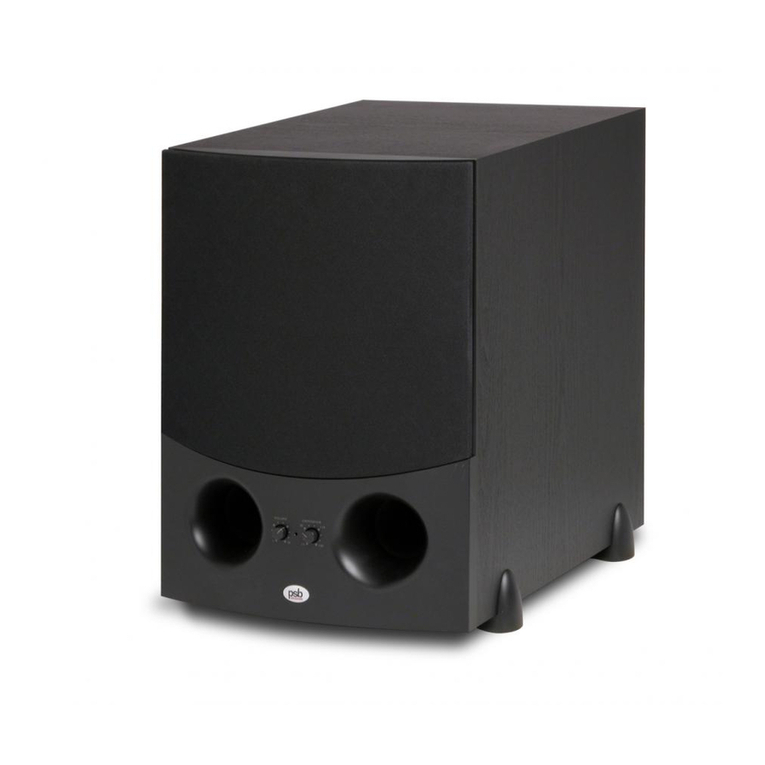
PSB
PSB SubSeries 6i User manual
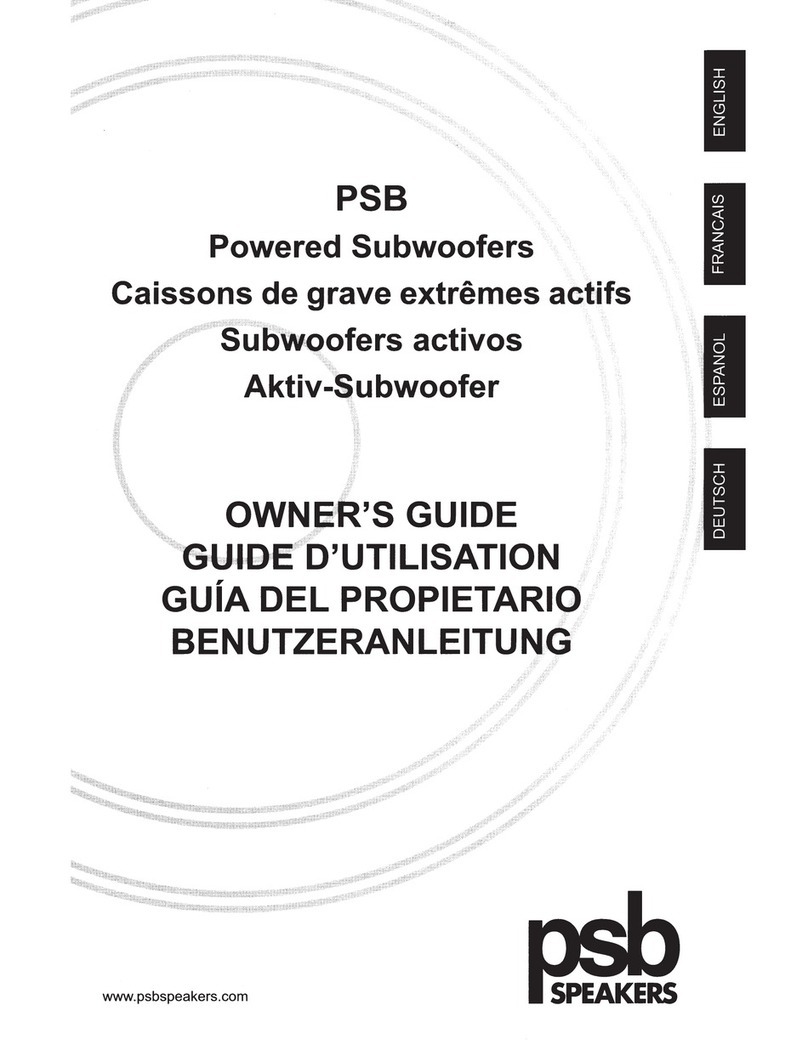
PSB
PSB Powered Subwoofers User manual

PSB
PSB SubsSonic SubSonic5i User manual
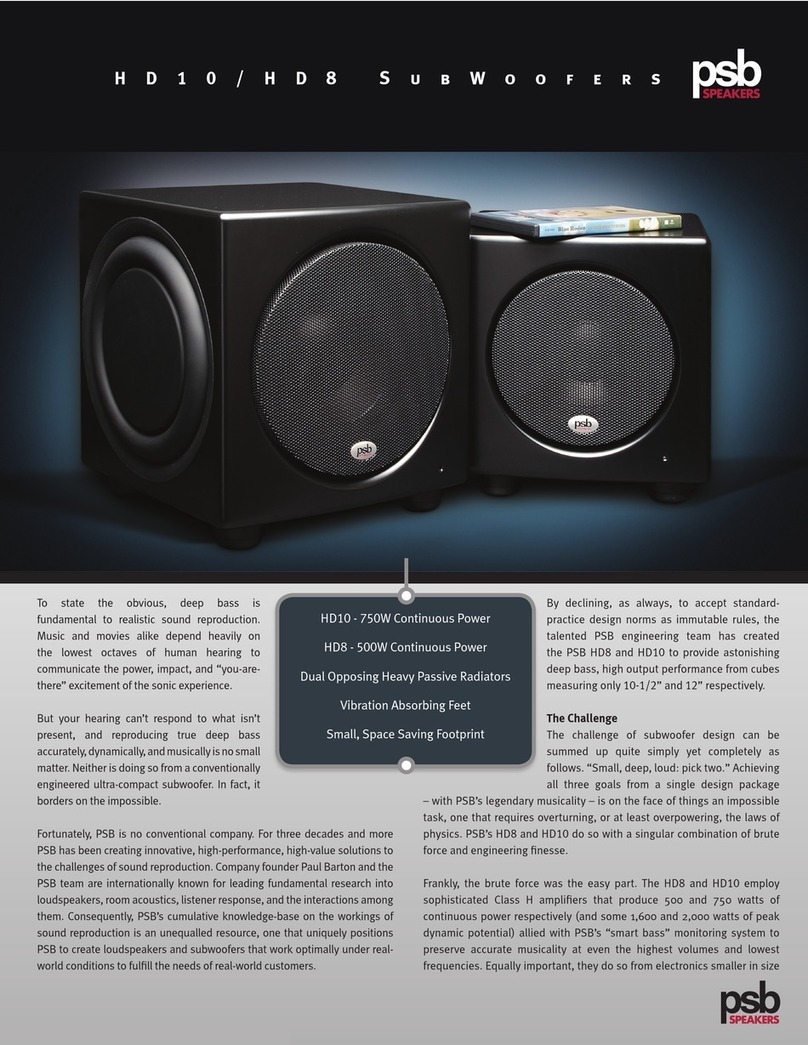
PSB
PSB HD10 User manual

PSB
PSB Powered Subwoofers User manual

PSB
PSB CHS212 User manual

PSB
PSB SubSeries 500 User manual

PSB
PSB SubSeries 500 User manual
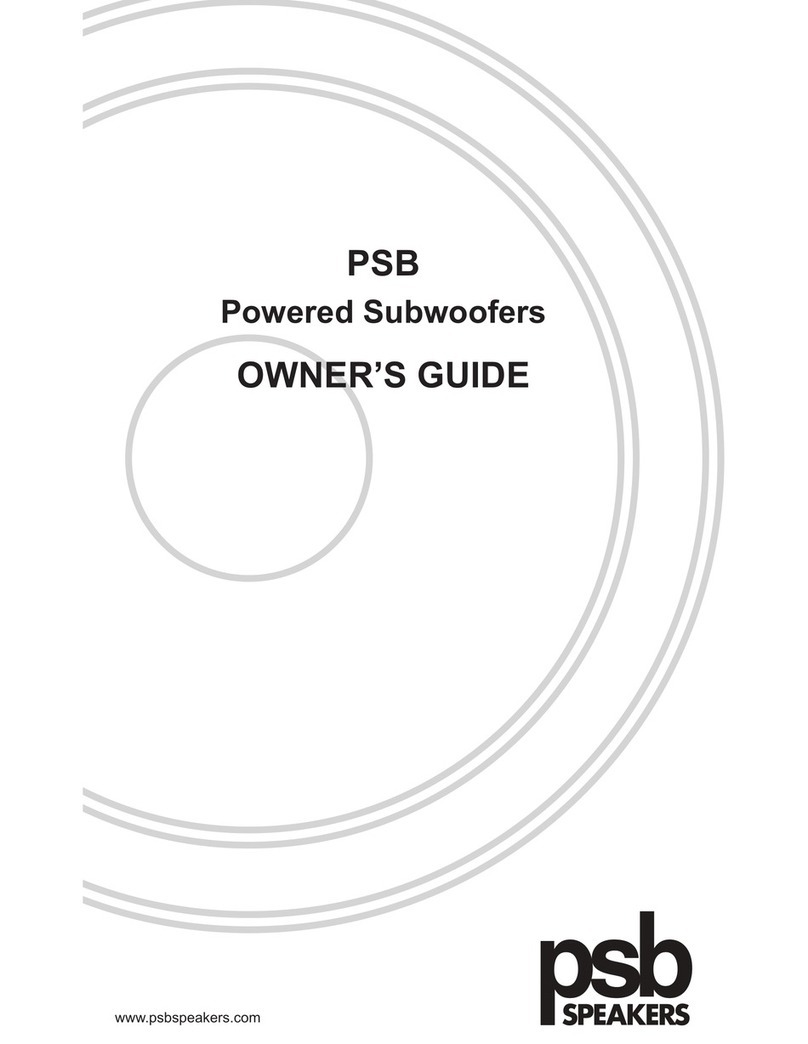
PSB
PSB SubSeries 450 User manual
